Quantitative Study of the Lateral Sealing Ability of Faults Considering the Diagenesis Degree of the Fault Rock: An Example from the Nantun Formation in the Wuerxun-Beier Sag in the Hailar Basin, China
Abstract
:1. Introduction
2. Geological Setting
3. Quantitative Analysis Method and Technique
3.1. Factors Influencing the Lateral Sealing Ability of the Faults
3.2. Determining the SGR&H Threshold of Lateral Fault Sealing
- (1)
- Determination of the SGR&H of the fault rock
- (2)
- Constraining the oil testing area
- (3)
- Determination of the SGR&H threshold for lateral fault sealing
- (4)
- Determination of the lateral fault sealing properties
4. Quantitative Analysis of the Lateral Sealing Ability of Faults in the Hailar Basin
4.1. Fault Characteristics and Method Applicability
4.2. Quantitative Analysis of the Lateral Sealing Ability of Faults
4.3. Analysis of Typical Cases
4.4. Analysis of Application Effect
5. Discussion
5.1. Differences in the Lateral Sealing Ability of Faults within Different Layers in the Same Area
5.2. Differences in the Lateral Sealing Ability of Faults within the Same Layer in Different Areas
5.3. Advantages and Limitations of the SGR&H Threshold Method
6. Conclusions
- (1)
- The lateral sealing ability of faults is controlled by multiple geological factors. For the faults developed in the Hailar Basin, which form fault rock seals, the influencing factors are the clay content of the fault rock (SGR), the degree of diagenesis of the fault rock, and the fault activity history. The degree of diagenesis can be represented by the burial depth of the fault rock. With higher SGR of the fault rock, the deeper the burial and the fault activity occurs before hydrocarbon accumulation such that the lateral sealing ability of the fault will be stronger, which is more favorable for oil and gas accumulation.
- (2)
- The lateral sealing property and the lateral sealing ability of a fault are two different but mutually restrictive concepts. The former depends on the relative difference in the entry pressures of the fault rock and the reservoir rock, while the latter depends on the relationship between the SGR value and the burial depth of the fault rock. For a set of reservoir rocks, the higher the RSF is, the smaller the critical entry pressure and the lower the SGR&H threshold required for the fault rock to become laterally sealed.
- (3)
- The lateral sealing ability of faults in different areas and within different layers is different. (a) In the same area, the thresholds of faults sealed in different layers are different because the deep strata are subjected to greater pressures and longer loading, so the faults are more likely to seal laterally; that is to say, the SGR&H threshold is relatively small. (b) Within the same layer, the thresholds for fault sealing in different areas are also different, and the threshold gradually decreases with increasing RSF.
Author Contributions
Funding
Data Availability Statement
Acknowledgments
Conflicts of Interest
References
- Zhang, F.Q.; Dilek, Y.; Chen, H.L.; Yang, S.F.; Meng, Q.A. Structural architecture and stratigraphic record of Late Mesozoic sedimentary basins in NE China: Tectonic archives of the Late Cretaceous continental margin evolution in East Asia. Earth-Sci. Rev. 2017, 171, 598–620. [Google Scholar] [CrossRef]
- Fu, X.F.; Dong, J.; Lv, Y.F.; Sun, Y.H. Fault structure characteristics of Wuerxun-Beier Depression in the Hailar Basin and their reservoir-controlling mechanism. Acta Geol. Sin. 2012, 86, 877–889. [Google Scholar] [CrossRef]
- Strand, J.; Langhi, L.; Ross, A.S.; Dyt, C. Coupled stratigraphic and fault seal modeling used to describe trap integrity in the frontier Bight Basin, Australia. Mar. Pet. Geol. 2017, 86, 474–485. [Google Scholar] [CrossRef]
- Min-Na, A.; Zhang, F.Q.; Yang, S.F.; Chen, H.L.; Batt, G.E.; Sun, M.D.; Meng, Q.A.; Zhu, D.F.; Cao, R.C.; Li, J.S. Early Cretaceous provenance change in the southern Hailar Basin, northeastern China and its implication for basin evolution. Cretac. Res. 2013, 40, 21–42. [Google Scholar] [CrossRef]
- Torabia, A.; Alaei, B.; Libak, A. Normal fault 3D geometry and displacement revisited, Insights from faults in the Norwegian Barents Sea. Mar. Pet. Geol. 2019, 99, 135–155. [Google Scholar] [CrossRef]
- Chester, F.M.; Logan, J.M. Implications for mechanical properties of brittle faults from observations of the Punchbowl fault zone, California. Pure Appl. Geophys. 1986, 124, 79–106. [Google Scholar] [CrossRef]
- Childs, C.; Manzocchi, T.; Walsh, J.J.; Bonson, C.J.; Nicol, A.; Schöpfer, M.P.J. A geometric model of fault zone and fault rock thickness variations. J. Struct. Geol. 2009, 31, 117–127. [Google Scholar] [CrossRef]
- Faulkner, D.R.; Mitchell, T.M.; Jensen, E.; Cembrano, J. Scaling of fault damage zones with displacement and the implications for fault growth processes. J. Geophys. Res. 2011, 116, B05403. [Google Scholar] [CrossRef]
- Brandes, C.; Tanner, D. Fault mechanics and earthquakes. Underst. Faults Detect. Dating Model. 2020, 2, 11–80. [Google Scholar] [CrossRef]
- Sibson, R.H. Fault rocks and fault mechanisms. J. Geol. Soc. Lond. 1977, 133, 191–213. [Google Scholar] [CrossRef]
- Shipton, Z.K.; Soden, A.M.; Kirkpatrick, J.D.; Bright, A.M.; Lunn, R.L. How thick is a fault? Fault displacement- thickness scaling revisited. Earthquakes: Radiated energy and the physics of faulting. Geophys. Monogr. Ser. 2006, 170, 193–198. [Google Scholar]
- Fossen, H. Structural Geology; Cambridge University Press: Cambridge, UK, 2010; 480p. [Google Scholar]
- Maqbool, A.U.R.; Moustafa, A.R.; Dowidar, H.; Yousef, H. Architecture of fault damage zones of normal faults, Gebel Ataqa area, Gulf of Suez rift, Egypt. Mar. Pet. Geol. 2016, 77, 43–53. [Google Scholar] [CrossRef]
- Choi, J.H.; Edwards, P.; Ko, K.; Kim, Y.S. Definition and classification of fault damage zones: A review and new methodological approach. Earth-Sci. Rev. 2016, 152, 70–87. [Google Scholar] [CrossRef]
- Boutareaud, S.; Wibberley, C.A.J.; Fabbri, O.; Shimamoto, T. Permeability structure and co-seismic thermal pressurization on fault branches: Insights from the Usukidani Fault, Japan. Geol. Soc. Lond. Spec. Publ. 2009, 299, 341–361. [Google Scholar] [CrossRef]
- Tanaka, H.; Hinoki, S.I.; Kosaka, K.; Lin, A.M.; Takemura, K.; Murata, A.; Miyata, T. Deformation mechanisms and fluid behavior in a shallow, brittle fault zone during coseismic and interseismic periods: Results from drill core penetrating the Nojima Fault, Japan. Island Arc. 2001, 10, 381–391. [Google Scholar] [CrossRef]
- Bruhn, R.L.; Parry, W.T.; Yonkee, W.A.; Thompson, T. Fracturing and hydrothermal alteration in normal fault zones. Pure Appl. Geophys. 1994, 142, 609–644. [Google Scholar] [CrossRef]
- Vermilye, J.M.; Scholz, C.H. The process zone: A microstructural view of fault growth. J. Geophys. Res. 1998, 103, 12223–12237. [Google Scholar] [CrossRef]
- Riley, P.R.; Goodwin, L.B.; Lewis, C.J. Controls on fault damage zone width, structure, and symmetry in the Bandelier Tuff, New Mexico. J. Struct. Geol. 2010, 32, 766–780. [Google Scholar] [CrossRef]
- Schueller, S.; Braathen, A.; Fossen, H.; Tveranger, J. Spatial distribution of deformation bands in damage zones of extensional faults in porous sandstones: Statistical analysis of field data. J. Struct. Geol. 2013, 52, 148–162. [Google Scholar] [CrossRef]
- Killick, A.M. Fault rock classification: An aid to structural interpretation in mine and exploration geology. S. Afr. J. Geol. 2003, 106, 395–402. [Google Scholar] [CrossRef]
- Woodcock, N.H.; Mort, K. Classification of fault breccias and related fault rocks. Geol. Mag. 2008, 145, 435–440. [Google Scholar] [CrossRef]
- Allan, U.S. Model for hydrocarbon migration and entrapment within faulted structures. AAPG Bull. 1989, 73, 803–811. [Google Scholar]
- Knipe, R.J.; Fisher, Q.J.; Jones, G.; Clennell, M.R.; Farmer, A.B.; Harrison, A.; Kidd, B.; Mcallister, E.; Porter, J.R.; White, E.A. Fault seal analysis, successful methodologies, application and future directions. Nor. Pet. Soc. Spec. Publ. 1997, 7, 15–38. [Google Scholar] [CrossRef]
- Reilly, C.; Nicol, A.; Walsh, J.J.; Kroeger, K. Temporal changes of fault seal and early charge of the Maui Gas-condensate field, Taranaki Basin, New Zealand. Mar. Pet. Geol. 2016, 70, 237–250. [Google Scholar] [CrossRef]
- Hubbert, M.K. Entrapment of Petroleum under Hydro-dynamic Conditions. AAPG Bull. 1953, 37, 1954–2026. [Google Scholar]
- Smith, D.A. Theoretical consideration of sealing and non-sealing faults. AAPG Bull. 1996, 50, 363–374. [Google Scholar]
- Bense, V.F.; Van den Berg, E.H.; Van Balen, R.T. Deformation mechanisms and hydraulic properties of fault zones in unconsolidated sediments, the Roer Valley Rift System, The Netherlands. Hydrogeol. J. 2003, 11, 319–332. [Google Scholar] [CrossRef]
- Lv, Y.F.; Huang, J.S.; Fu, G.; Fu, X.F. Quantitative study on fault sealing ability in sandstone and mudstone thin interbed. Acta Pet. Sin. 2009, 30, 824–829. [Google Scholar] [CrossRef]
- Lv, Y.F.; Wang, W.; Hu, X.L.; Fu, G.; Shi, J.J.; Wang, C.; Liu, Z.; Jiang, W.Y. Quantitative evaluation method of fault lateral sealing. Pet. Explor. Dev. 2016, 43, 340–347. [Google Scholar] [CrossRef]
- Pei, Y.; Paton, D.A.; Knipe, R.J.; Wu, K.Y. A review of fault sealing behaviour and its evaluation in siliciclastic rocks. Earth-Sci. Rev. 2015, 150, 121–138. [Google Scholar] [CrossRef]
- Bouvier, J.D.; Kaars-Sijpesteijn, C.H.; Kluesner, D.F.; Onyejekwe, C.C.; Van Der Pal, R.C. Three-dimensional seismic interpretation and fault sealing investigations, Nun River Field, Nigeria. AAPG Bull. 1989, 73, 1397–1414. [Google Scholar]
- Fulljames, J.R.; Zijerveld, L.J.J.; Franssen, R.C.M.W. Fault seal processes: Systematic analysis of fault seals over geological and production time scales. Nor. Pet. Soc. Spec. Publ. 1997, 7, 51–59. [Google Scholar] [CrossRef]
- Lindsay, N.G.; Murphy, F.C.; Walsh, J.J.; Watterson, J. Outcrop studies of shale smears on fault surface. In The Geological Modelling of Hydrocarbon Reservoirs and Outcrop Analogues by Flint, S.S. and Bryant, I.D.; John Wiley & Sons, Ltd.: Hoboken, NJ, USA, 2009; pp. 113–123. [Google Scholar] [CrossRef]
- Yielding, G.; Freeman, B.; Needham, D.T. Quantitative fault seal prediction. AAPG Bull. 1997, 81, 897–917. [Google Scholar]
- Freeman, B.; Yielding, G.; Needham, D.T.; Badley, M.E. Fault seal prediction: The gouge ratio method. Geol. Soc. Lond. Spec. Publ. 1998, 127, 19–25. [Google Scholar] [CrossRef]
- Foxford, K.A.; Walsh, J.J.; Watterson, J.; Garden, I.R.; Guscott, S.C.; Burley, S.D. Structure and content of the Moab Fault Zone, Utah, USA, and its implications for fault seal prediction. Geol. Soc. Lond. Spec. Publ. 1998, 147, 87–103. [Google Scholar] [CrossRef]
- Bretan, P. Assessing the Predictive Capability of the Empirical Shale Gouge Ratio–Buoyancy Pressure Calibration: Implications for Estimating CO2 Column Heights. Geol. Soc. Lond. Spec. Publ. 2023, 528. [Google Scholar] [CrossRef]
- Wilson, P. A Data Science Approach to Uncertainty Evaluation in Fault-Seal Analysis for Exploration Applications in Siliciclastic Reservoirs. SPE J. 2023, 28, 1912–1924. [Google Scholar] [CrossRef]
- Yielding, G. Shale Gouge Ratio—Calibration by geohistory. Nor. Pet. Soc. Spec. Publ. 2002, 11, 1–15. [Google Scholar] [CrossRef]
- Çiftçi, N.B.; Langhi, L.; Strand, J.; Divko, L.G. Efficiency of a faulted regional top seal, Lakes Entrance Formation, Gippsland Basin, SE Australia. Pet. Geosci. 2014, 20, 241–256. [Google Scholar] [CrossRef]
- Fisher, Q.J.; Schaefer, F.; Kaminskaite, I.; Dewhurst, D.N.; Yielding, G. Fault and top seals thematic collection: A perspective. Pet. Geosci. 2021, 27. [Google Scholar] [CrossRef]
- Liu, Y.Z.; Zeng, J.H.; Qiao, J.C.; Chen, D.X.; Li, S.Q.; Dong, Y.Y.; Liu, S.N.; Long, H. Integration of charging time, migration pathways and sealing analysis to understand hydrocarbon accumulation in complex fault blocks, the Pinghu Slope Belt of the Xihu Depression, East China Sea Basin. Mar. Pet. Geol. 2023, 152, 106241. [Google Scholar] [CrossRef]
- Færseth, R.B.; Johnsen, E.; Sperrevik, S. Methodology for risking fault seal capacity, implications of fault zone architecture. AAPG Bull. 2007, 91, 1231–1246. [Google Scholar] [CrossRef]
- Liu, Z.H.; Liu, H.J.; Wang, P.; Wu, X.M.; Zhu, D.F.; Wan, C.B. Discovery of compressional structure in Wuerxun–Beier Sag in Hailar Basin of Northeastern China and its geological significance. Earth Sci. Front. 2009, 16, 138–146. [Google Scholar] [CrossRef]
- Zheng, H.; Sun, X.M.; Zhu, D.F.; Tian, J.X.; Wang, P.J.; Zhang, X.Q. Characteristics and factors controlling reservoir space in the cretaceous volcanic rocks of the Hailar Basin, NE China. Mar. Pet. Geol. 2018, 91, 749–763. [Google Scholar] [CrossRef]
- Zhang, T.L.; Chen, Y.; Chen, J.F.; Zhu, D.F.; Zhao, X.Q.; Zhang, C. Relationship between magma activity and CO2 gas accumulation in central fault zone of Hailaer Tmuchage Basin. Nat. Gas Geosci. 2011, 22, 664–669. [Google Scholar]
- Cui, J.P.; Ren, Z.L.; Xiao, H.; Chen, Q.H. Study on temperature distribution and controlling factors in the Hailar Basin. Chin. J. Geol. 2007, 42, 656–665. [Google Scholar]
- Liu, H.L.; Li, Z.; Peng, Y.; Meng, Q.A.; Li, G.; Hu, Y.L.; Zhang, P.H.; Li, D.; Su, G.P.; Long, W. Structural characteristics and formation mechanisms of Bayanhushu Sag in Hailar Basin, north-east China: A study based on structural physical simulation. Geol. J. 2021, 57, 317–339. [Google Scholar] [CrossRef]
- Jia, R.; Liu, B.; Fu, X.F.; Gong, L.; Liu, Z.D. Transformation mechanism of a fault and its associated microstructures in low-porosity rocks: A case study of the Tanan Depression in the Hailar-Tamtsag Basin. J. Mar. Sci. Eng. 2019, 9, 286. [Google Scholar] [CrossRef]
- Lou, R.; Sun, Y.H.; Fan, T.E.; Fan, H.J.; Liu, L. Influence of multi-trend major fault reactivation during multiphase rifting: Beier Depression, Hailar Basin, NE China. Geol. Mag. 2022, 159, 1767–1786. [Google Scholar] [CrossRef]
- Liu, Z.B.; Zhao, R.S.; Yan, L.; Yu, Y.H. Depositional system characteristics of the first member of the Nantun Formation in Tanan sag, the Hai-Ta Basin. Oil Gas Geol. 2013, 34, 743–750. [Google Scholar] [CrossRef]
- Wang, C.S.; Scott, R.W.; Wan, X.Q.; Graham, S.A.; Huang, Y.J.; Wang, P.J.; Wu, H.C.; Dean, H.C.; Zhang, L.M. Late Cretaceous climate changes recorded in Eastern Asian lacustrine deposits and North American Epieric sea strata. Sci. Technol. Innov. Her. 2013, 126, 275–299. [Google Scholar] [CrossRef]
- Gibson, R.G. Physical character and fluid-flow properties of sandstone-derived fault zones. Geol. Soc. Lond. Spec. Publ. 1998, 127, 83–97. [Google Scholar] [CrossRef]
- Fisher, Q.J.; Knipe, R.J. The permeability of faults within siliciclastic petroleum reservoirs of the North Sea and Norwegian Continental Shelf. Mar. Pet. Geol. 2001, 18, 1063–1081. [Google Scholar] [CrossRef]
- Fu, X.F.; Pan, G.Q.; He, X.Y.; Xuan, C.J.; Lv, Y.J. Lateral sealing of faults for shallow biogas in Heidimiao Formation of the Southern Daqing Placanticline. Acta Pet. Sin. 2009, 30, 678–684. [Google Scholar] [CrossRef]
- Nicol, A.; Childs, C. Cataclasis and silt smear on normal faults in weakly lithified turbidites. J. Struct. Geol. 2018, 117, 44–57. [Google Scholar] [CrossRef]
- Walderhaug, O. Kinetic modeling of quartz cementation and porosity loss in deeply buried sandstone reservoirs. AAPG Bull. 1996, 80, 731–745. [Google Scholar]
- Fisher, Q.J.; Knipe, R.J. Fault sealing processes in siliciclastic sediments. Geol. Soc. 1998, 147, 117–134. [Google Scholar] [CrossRef]
- Vrolijk, P.J.; Urai, J.L.; Kettermann, M. Clay smear, Review of mechanisms and applications. J. Struct. Geol. 2016, 86, 95–152. [Google Scholar] [CrossRef]
- Bjørnarå, T.I.; Skurtveit, E.; Michie, E.A.H.; Smith, S.A. Characterizing along- and across-fault fluid-flow properties for assessing flow rates and overburden fluid migration along faults: A case study from the North Sea. Pet. Geosci. 2023, 29, 159–183. [Google Scholar] [CrossRef]
- Cuisiat, F.; Skurtveit, E. An experimental investigation of the development and permeability of clay smears along faults in uncemented sediments. J. Struct. Geol. 2010, 32, 1850–1863. [Google Scholar] [CrossRef]
- Yielding, G.; Bretan, P.; Freeman, B. Fault Seal Calibration, A Brief Review. Geol. Soc. Lond. 2010, 347, 243–255. [Google Scholar] [CrossRef]
- Guglielmia, Y.; Birkholzera, J.; Rutqvista, J.; Jeannea, P.; Nussbaum, P. Can Fault Leakage Occur Before or Without Reactivation? Results from an In Situ Fault Reactivation Experiment at Mont Terri. Energy Procedia 2017, 114, 3167–3174. [Google Scholar] [CrossRef]
- Zulqarnain, M.; Zeidouni, M.; Hughes, R.G. Implications of fault structure heterogeneities, dissolution and capillary trapping mechanisms for CO2, storage integrity. Int. J. Greenh. Gas Control. 2018, 76, 53–61. [Google Scholar] [CrossRef]
- Evans, J.P. Thickness-displacement relationships for fault zones. J. Struct. Geol. 1990, 12, 1061–1065. [Google Scholar] [CrossRef]
- Wang, H.W. The Distribution of Caprock and Evaluation of Fault Seal Ability of Hailar Basin. Master’s Thesis, Northwest University, Xi’an, China, 2004; p. 165. [Google Scholar]
- Traynor, J.J.; Sladen, C. Tectonic and stratigraphic evolution of the Mongolian People’s Republic and its influence on hydrocarbon geology and potential. Mar. Pet. Geol. 1995, 12, 35–52. [Google Scholar] [CrossRef]
- Cui, J.P.; Zhong, G.R.; Ren, Z.L. Formation stages of oil-gas reservoirs in Hailar Basin, Inner Mongolia. Geoscience 2012, 26, 801–807. [Google Scholar] [CrossRef]
- Song, L.; Liu, Z.H.; Wang, C.; Gao, X.; Liu, X.W. Multistage structural deformations of a superimposed basin system and its tectonic response to regional geological evolution: A case study from the Late Jurassic-Early Cretaceous Tanan depression, Hailar-Tamtsag basin. Mar. Pet. Geol. 2019, 110, 1–20. [Google Scholar] [CrossRef]
- Bretan, P.; Yielding, G.; Jones, H. Using calibrated shale gouge ratio to estimate hydrocarbon column heights. AAPG Bull. 2003, 87, 397–413. [Google Scholar] [CrossRef]
- Grauls, D.J.; Baleix, J.M. Role of overpressures and in situ stresses in fault-controlled hydrocarbon migration. Mar. Pet. Geol. 1994, 11, 734–742. [Google Scholar] [CrossRef]
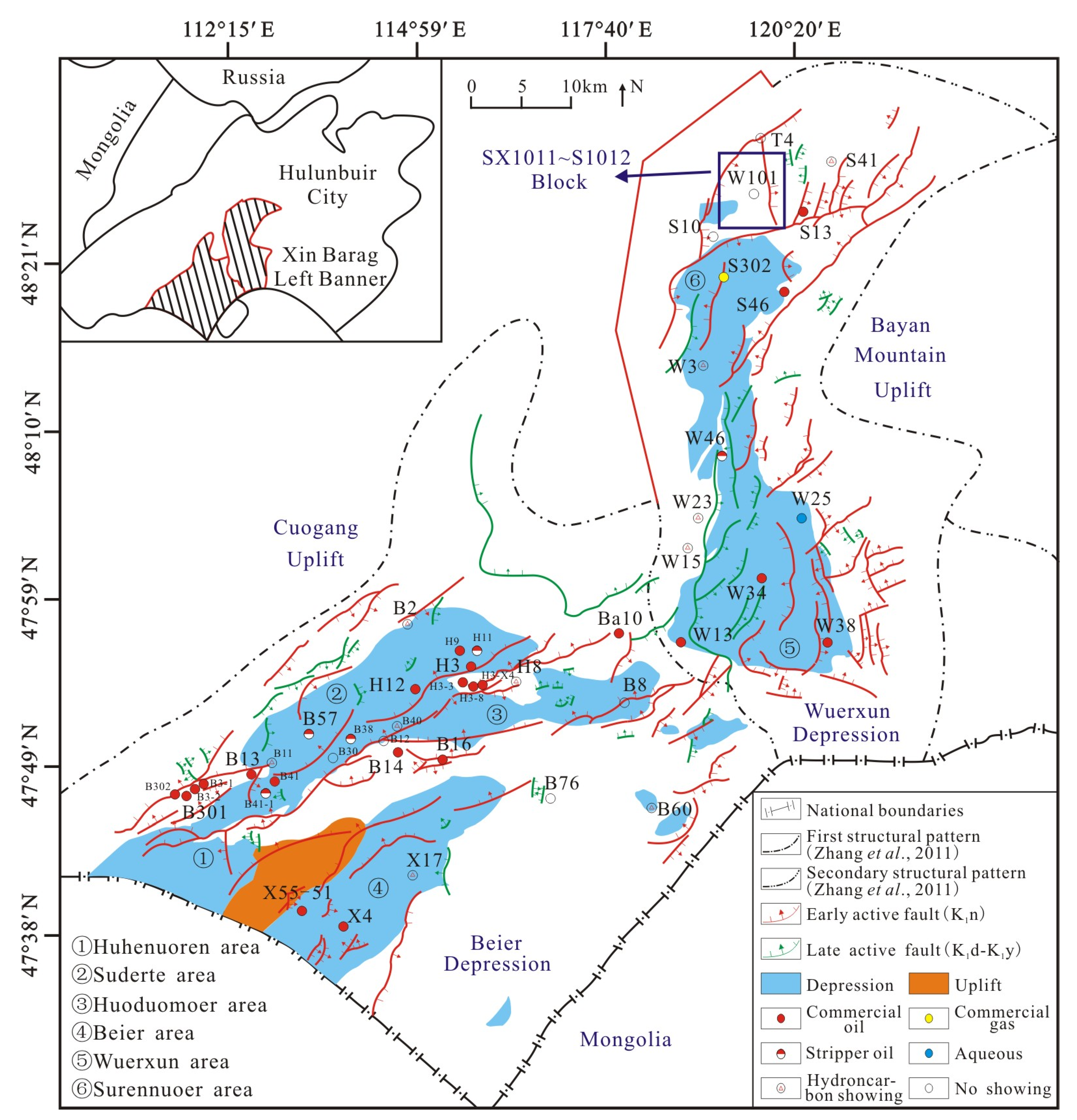
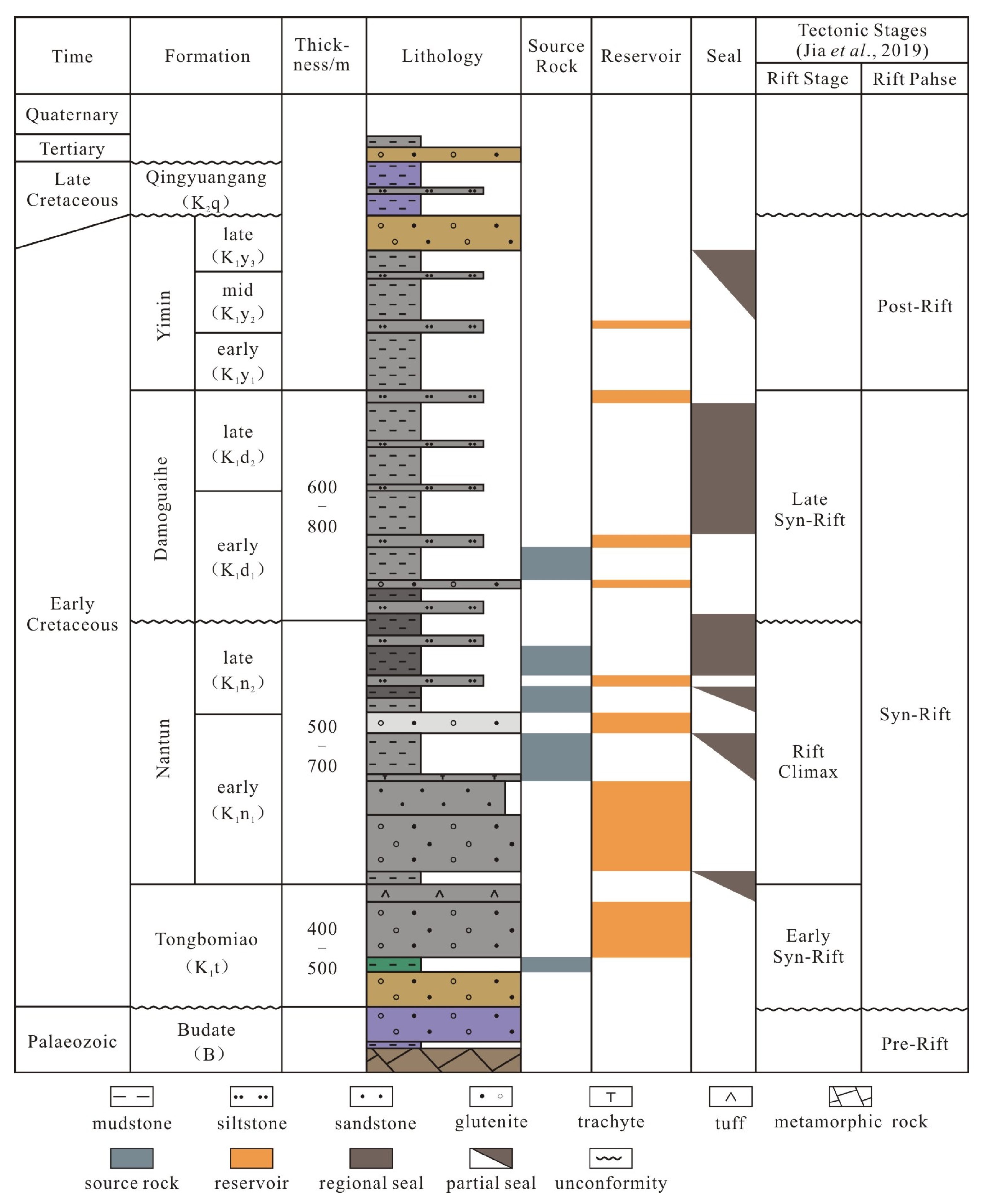
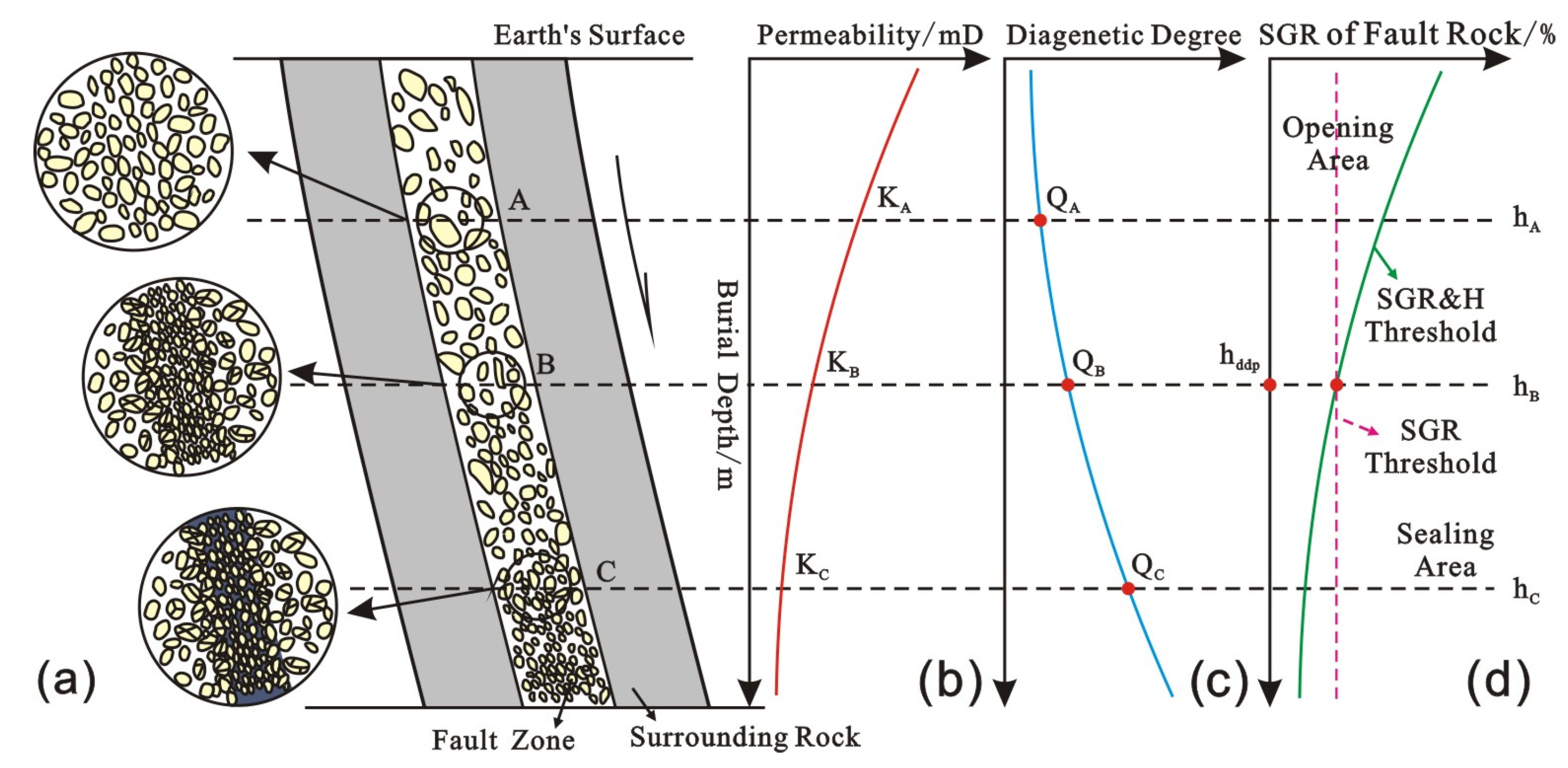

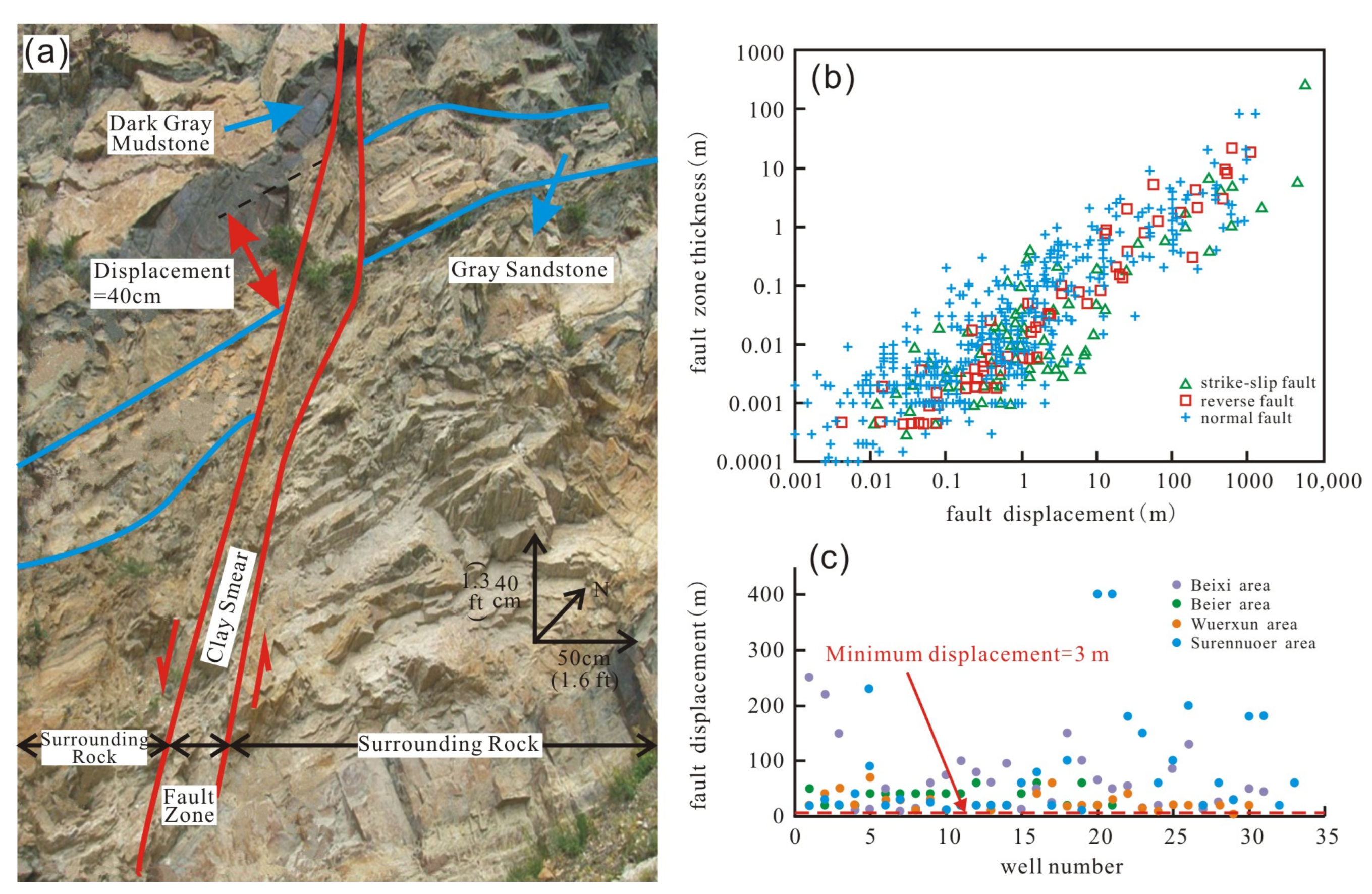
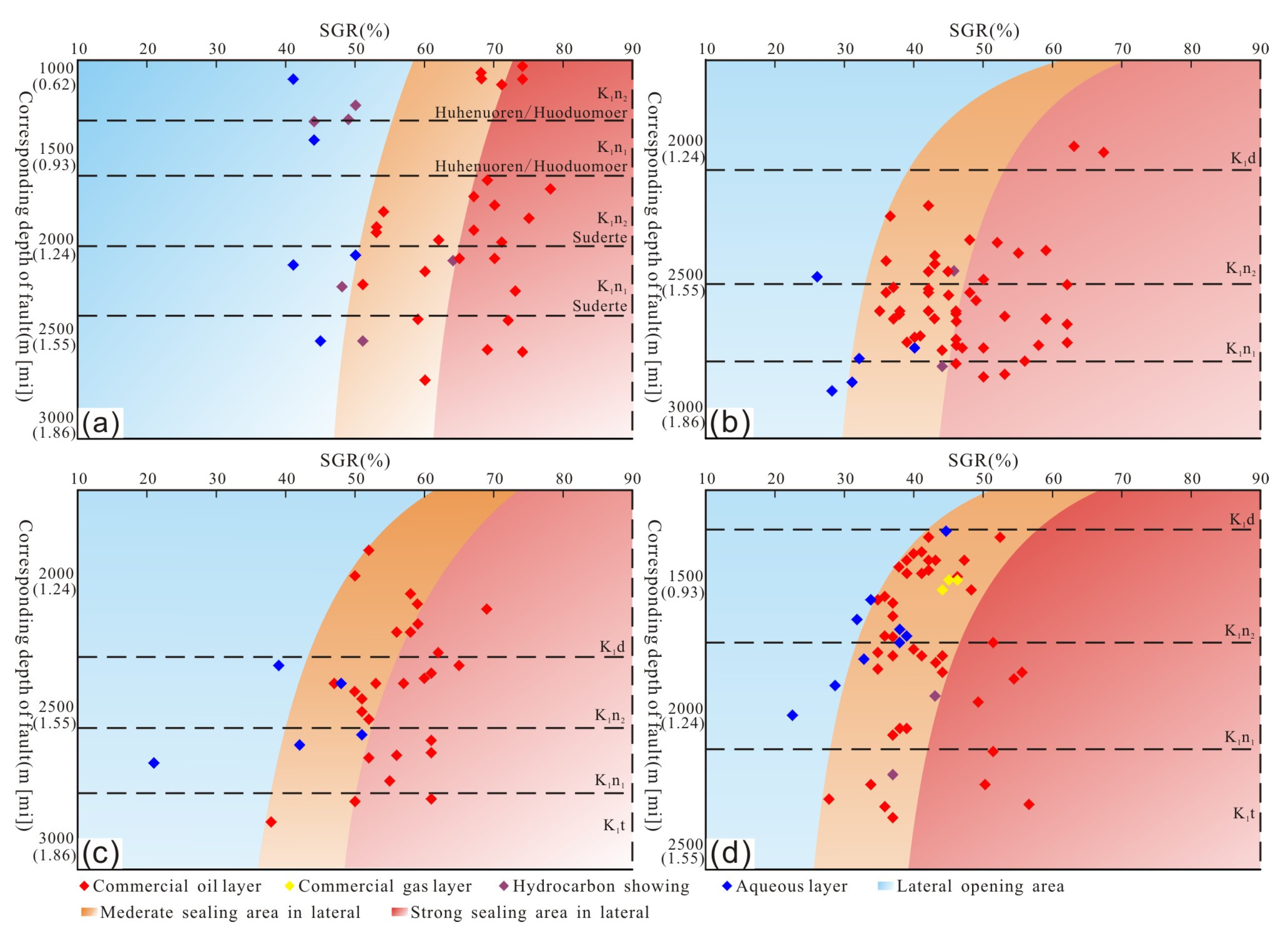
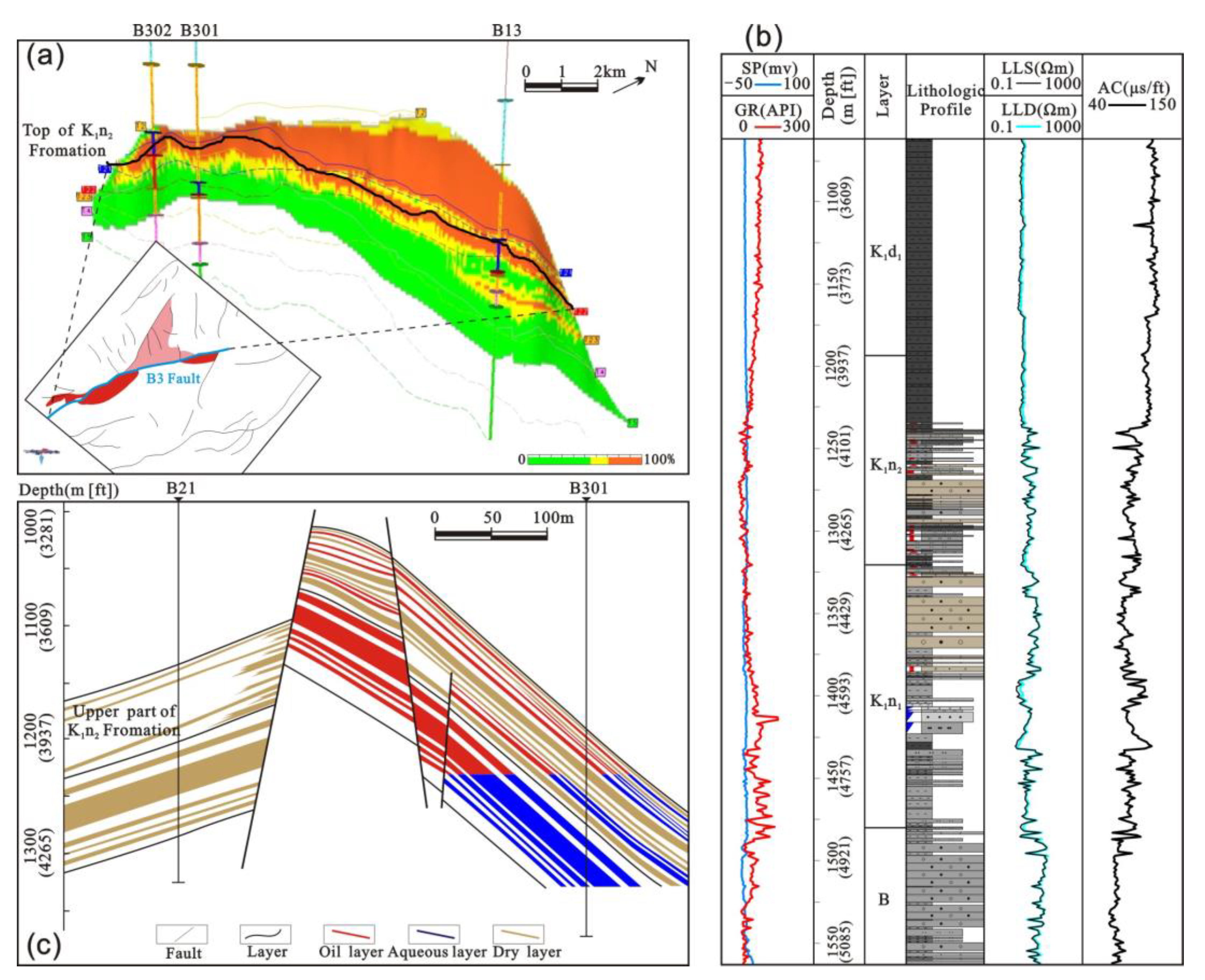
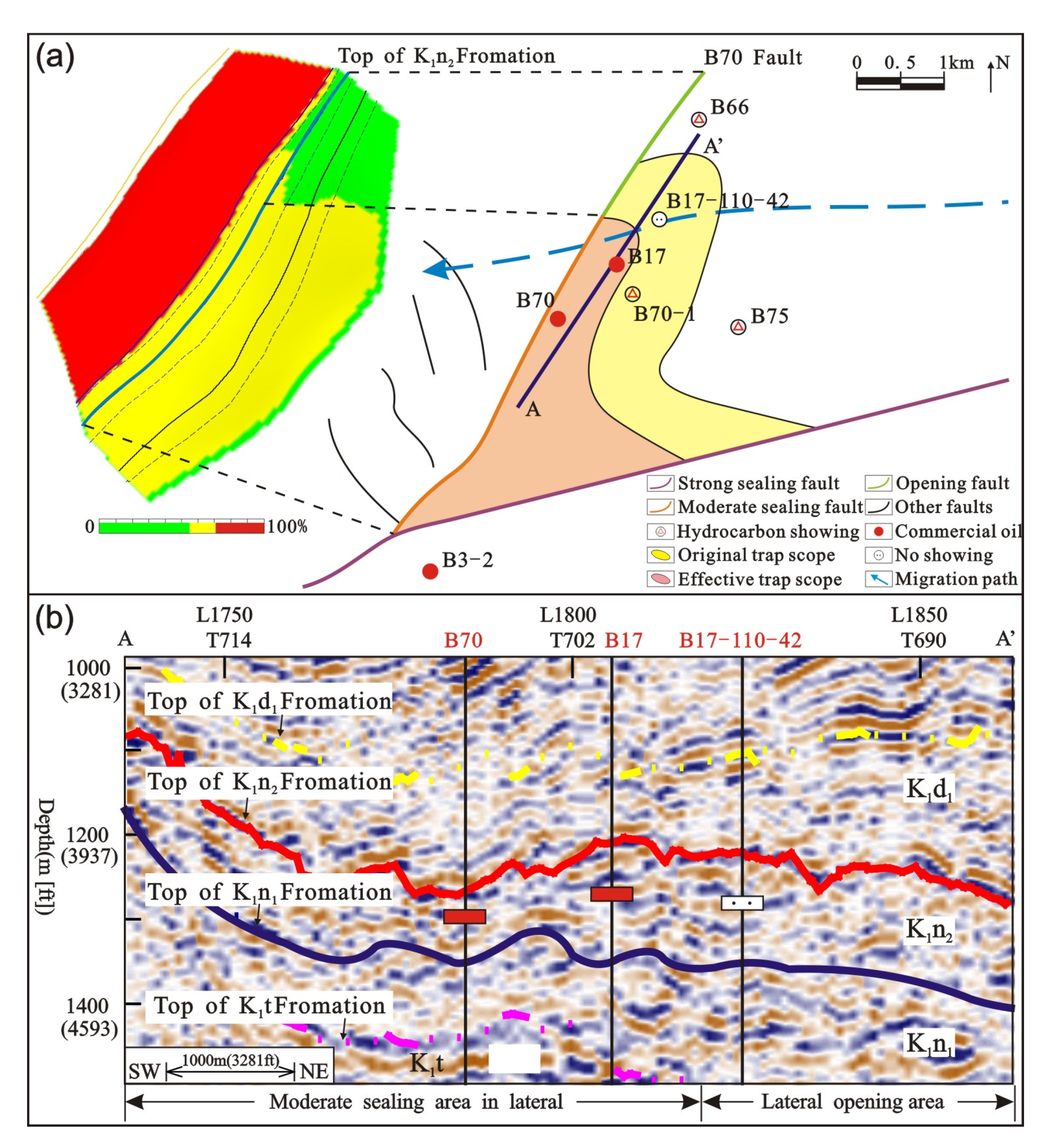

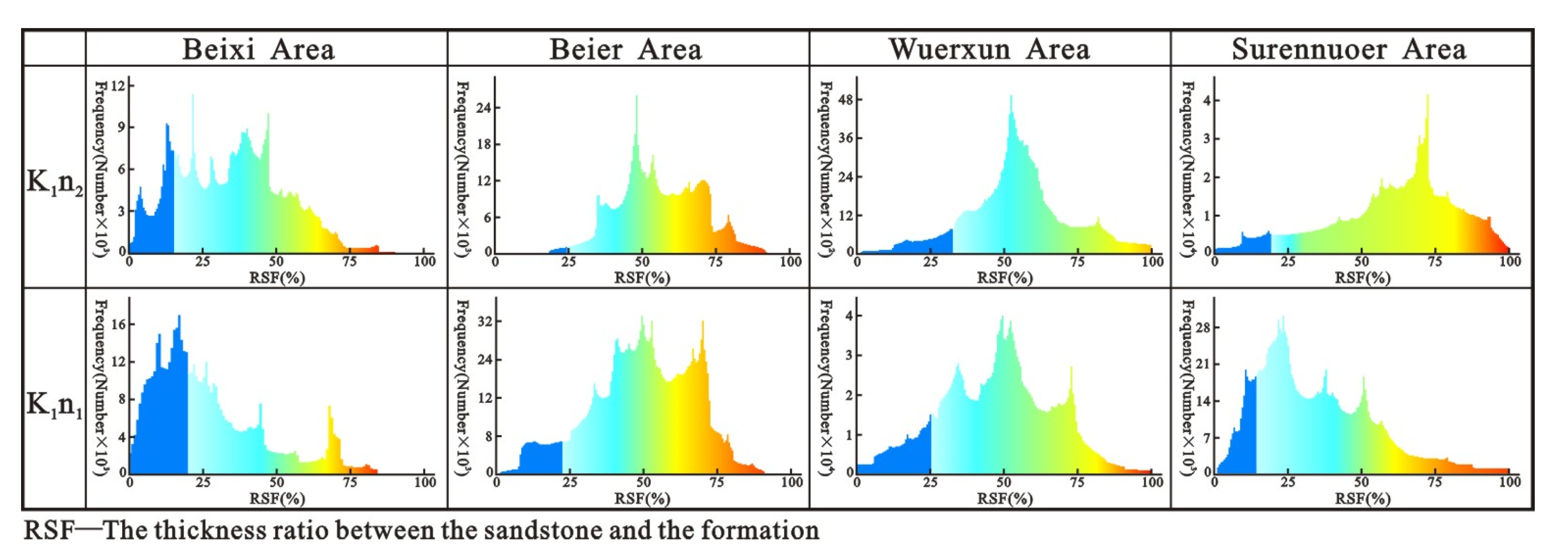
| Area | Well | Testing Layer | Testing Conclusion | Daily Oil Production (Layer Number) (t) (Layer) | Fault Displacement (m [ft]) | Buried Depth (m [ft]) | SGR (%) | Fault Sealing Property |
|---|---|---|---|---|---|---|---|---|
| Beixi Area | B3 | K1n2 | Oil | 6.97 (5) | 15 (49) | 1130 (3707) | 71 | Strong Seal |
| H3-12 | K1n2 | Showing | / | 23 (75) | 1245 (4085) | 50 | Open | |
| D124-137 | K1n1 | Oil | 0.31 (1) | 175 (574) | 1790 (5873) | 62 | Moderate seal | |
| Beier Area | X03-61 | K1n2 | Water | 0 (1) | 12 (39) | 2507 (8225) | 26 | Open |
| X2-1 | K1n2 | Oil | 8.48 (1) | 8 (26) | 2440 (8005) | 43 | Moderate seal | |
| X5 | K1n1 | Oil | 8.64 (3) | 3 (10) | 2696 (8845) | 62 | Strong Seal | |
| X09-55 | K1n1 | Showing | 0.13(3) | 13 (43) | 2599 (8527) | 27 | Open | |
| Wuerxun Area | W112-88 | K1n1 | Oil | 1.27 (1) | 25 (82) | 2675 (8776) | 56 | Strong Seal |
| W144-108 | K1n1 | Water | 0 (3) | 5 (16) | 2033 (6670) | 40 | Open | |
| W148-70 | K1n1 | Water | 0 (4) | 18 (59) | 2713 (8901) | 21 | Open | |
| W29 | K1n1 | Oil | 2.09 (4) | 23 (75) | 2489 (8166) | 53 | Moderate seal | |
| Surennuoer Area | S31 | K1n2 | Oil | 0.21 (1) | 48 (157) | 1545 (5069) | 47 | Moderate seal |
| XW1 | K1n2 | Water | 0.06 (4) | 60 (197) | 1601 (5253) | 33 | Open | |
| S20 | K1n1 | Oil | 4.37 (3) | 9 (30) | 2065 (6775) | 38 | Moderate seal | |
| S15 | K1n1 | Water | 0 (2) | 32 (105) | 1911 (6270) | 28 | Open |
Disclaimer/Publisher’s Note: The statements, opinions and data contained in all publications are solely those of the individual author(s) and contributor(s) and not of MDPI and/or the editor(s). MDPI and/or the editor(s) disclaim responsibility for any injury to people or property resulting from any ideas, methods, instructions or products referred to in the content. |
© 2023 by the authors. Licensee MDPI, Basel, Switzerland. This article is an open access article distributed under the terms and conditions of the Creative Commons Attribution (CC BY) license (https://creativecommons.org/licenses/by/4.0/).
Share and Cite
Hu, X.; Lv, Y.; Liu, Y.; Liu, J. Quantitative Study of the Lateral Sealing Ability of Faults Considering the Diagenesis Degree of the Fault Rock: An Example from the Nantun Formation in the Wuerxun-Beier Sag in the Hailar Basin, China. Resources 2023, 12, 98. https://doi.org/10.3390/resources12090098
Hu X, Lv Y, Liu Y, Liu J. Quantitative Study of the Lateral Sealing Ability of Faults Considering the Diagenesis Degree of the Fault Rock: An Example from the Nantun Formation in the Wuerxun-Beier Sag in the Hailar Basin, China. Resources. 2023; 12(9):98. https://doi.org/10.3390/resources12090098
Chicago/Turabian StyleHu, Xinlei, Yanfang Lv, Yang Liu, and Junqiao Liu. 2023. "Quantitative Study of the Lateral Sealing Ability of Faults Considering the Diagenesis Degree of the Fault Rock: An Example from the Nantun Formation in the Wuerxun-Beier Sag in the Hailar Basin, China" Resources 12, no. 9: 98. https://doi.org/10.3390/resources12090098
APA StyleHu, X., Lv, Y., Liu, Y., & Liu, J. (2023). Quantitative Study of the Lateral Sealing Ability of Faults Considering the Diagenesis Degree of the Fault Rock: An Example from the Nantun Formation in the Wuerxun-Beier Sag in the Hailar Basin, China. Resources, 12(9), 98. https://doi.org/10.3390/resources12090098






